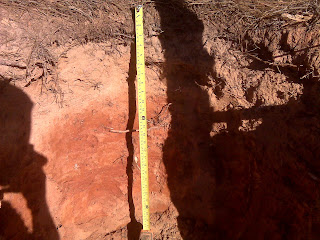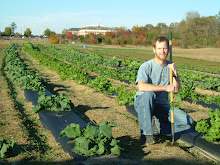I'm teaching the lab portion for soil morphology this semester. Just got back from the field now.
This is what we call a soil ped. "Ped" is a great scrabble word, btw.
We use peds to describe the soil structure using terms such as "subangular blocky", "granular", etc.
The ped above is weathered parent material, or saprolite, and can be found in the lower soil horizons, which in this case we would probably describe as a BC horizon.
When we go to the field to describe soils, we look at the soil profile. Sometimes the soil horizons are easy to pick out, most of the time they are not. They are difficult to see in this picture. But what you can see is the moisture deficit in the upper 10 inches of soil due to the last three years of drought and the well-drained nature of this soil.




9 comments:
Hi Mike,
I need you to explain the soil morphology to me in layman's terms. Is it testing the condition etc. of the soil? That test card looks like it indicates content/nutrition of soils by colour.
On the anniv. of Darwin's birth the photos look very apt.
Cool photos. Yes, you need some more explanation with this!
Well done Mike giving practicals in the field is great experience for your CV.
You're right. I added some description to the photos.
It's hard to do all that typing on my Blackberry in the field, when i should be helping the students!
Fair comment!
the photos are beautiful..science is amazing!!
Hi,
I'm a grad student and I'm working on my dissertation which is looking at soil color in relation to forensic and non-forensic excavation. You have the best picture I've seen showing use of a Munsell Chart. Would it be possible for me to use it as an illustration in my paper? If so, how would you like it credited?
Thanks
cool. i also have an experience do soil morphology in the national park in Malaysia. I still studying in this course and want to grab as much as i can experience that will be useful for me after i graduated.
Post a Comment